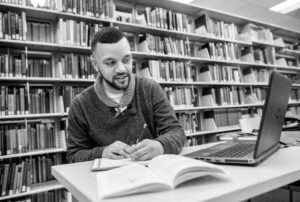
Many lower income students struggle to graduate college, beset with a bevy of challenges—financial, logistical, health-related—that make it hard to complete their classwork. Administrators at Georgia State University in Atlanta decided to take on the problem. Courtesy of Steve Thackston/Georgia State.
Students like Tyler Mulvenna drop out of college all the time, for all the wrong reasons.
Mulvenna was bright and resourceful and full of promise when he enrolled at Georgia State University in downtown Atlanta seven years ago, but he jumped into a higher education system stacked against anyone who is a first-generation college student, who does not have money, and who is non-white. Mulvenna had all three strikes against him. He is biracial, and was raised by a single mother in a small town 40 miles southwest of Atlanta. He was the first in his family to go to college and could draw on no resources beyond what he could cobble together from grants, loans, and the jobs he worked on evenings and weekends.
But Mulvenna was fortunate in one way: timing. Just a few years before Mulvenna arrived on campus, Georgia State had an undergraduate drop-out rate of well over 50 percent. Most, like Mulvenna, were capable and eager to learn but hit brick walls because of money, university bureaucracy, or both.
In the wake of the 2008 recession, though, Georgia State administrators decided it was no longer acceptable to wish good luck to promising students and then watch them fail over and over. The university went out on a limb and took responsibility for those it had deemed worthy of admission—and Mulvenna, with this support, was able to blossom into a star student.
Today as the United States grapples with its legacy of racial bias and a yawning gulf between rich and poor, many educational institutions are wondering how they can change and do better. Georgia State offers an inspiring glimpse of how things can be different.
Instead of clinging to the status quo, Georgia State chose to turn its leadership structure upside down, restructuring the jobs performed by professors and administrators around students’ needs, not the other way around. The results have been extraordinary. Georgia State has eliminated all achievement gaps between rich and poor, and between white and nonwhite students. It has also enjoyed a dramatic leap in the number of lower-income students on campus (now well over half the student body) and a parallel leap in graduation numbers.
Tyler Mulvenna could have dropped out of school at any of several critical junctures. The first big crunch came at the end of his freshman year, when a maddening combination of state regulations, university strictures, and financial realities blocked his path to a crucial state grant, without which he could not afford to continue. Mulvenna had come to Georgia State with a high school grade point average just shy of the 3.0 he needed to qualify for Georgia’s merit-based HOPE scholarship, which covers most tuition costs, and he’d staked everything on doing well enough in his freshman year to earn the scholarship thereafter.
Sure enough, Mulvenna sailed through his classes, but at the end of the year he found himself three credit hours short of the 30 required to qualify for HOPE. That was because Georgia State had put him in a special support program for academically promising students from vulnerable backgrounds, and the program had put a cap on the number of credit hours he could take at 27.
Mulvenna had been learning French—which would end up being one of his three majors—and he decided he’d make up the credits with a summer course in France, even winning a scholarship to cover some of the travel expenses. But he was still around $2,000 short of what he needed. The bill for summer tuition was due up front, but the HOPE money wouldn’t come through until fall.
He was a thriving student with a 3.2 GPA, and he’d hit a dead end at exactly the moment he should have been receiving maximum encouragement. It didn’t help that he’d crashed and almost totaled his car the summer after high school and couldn’t work as many hours as he’d planned. Unable to build up any savings, he’d taken out a high-interest commercial loan and was struggling to pay it back.
What came to his aid at this first juncture was a university micro-grant, designed for just this sort of eventuality, when an academically strong student is just a few hundred dollars short of what they need to keep going. Georgia State had introduced these grants just a year before Mulvenna enrolled, calculating—correctly—that the investment would pay for itself. The university would recoup thousands of dollars in continuing tuition fees and grants that would have been lost if the student dropped out.
Then came sophomore year. Thanks to HOPE, Mulvenna could afford his classes, but he was still drowning in debt and needed to work. Since he couldn’t afford a car and he couldn’t get to a job without one, he persuaded an auto mechanic in his family to stretch out the crumpled body of the Ford Fusion he’d smashed up a year earlier so it would be more or less roadworthy. It was a desperate move, because the car couldn’t pass the state tests required to get license plates. Without tags, Mulvenna was at risk of being ticketed every time he drove or parked on the street. But he depended on the car, sleeping in it several nights a week to save himself the gas he’d otherwise need to commute to and from his mother’s house.
Things became a little easier junior year, because Mulvenna was finally able to afford campus housing. But the pressure of studying full-time while logging as many as 30 hours a week at paying jobs was unrelenting. Mulvenna came down with shingles, strep throat, tonsilitis, and mononucleosis, each of which disrupted his studies and his ability to pay for them.

Microgrants from the university helped Tyler Mulvenna graduate with a triple major. Courtesy of Carolyn Richardson/Georgia State.
Any of these setbacks could have ended his studies—and without an additional two micro-grants from Georgia State before graduation, they would have. Instead, Mulvenna graduated on time with a triple major in French, marketing and international business—and a rack of university honors to his name.
Similar problems derail hundreds of thousands of students across the country each year. Students rise to the academic challenge of college but cannot always handle the precariousness of scrimping for every dollar when one slip-up or unforeseen crisis—a family illness, or an overstretched credit card, or a scheduling clash pushing a key course requirement back by a semester—can blow up their finances and make it impossible to continue in higher education.
Guiding Georgia State’s radically different approach was the firm refusal to accept that students from disadvantaged backgrounds were doomed to fail in large numbers. Tim Renick, the university’s student success guru and driver of its most important reforms, knew this received wisdom was wrong because he’d seen students of all kinds thrive during his years as a gifted young religious studies professor.
When Renick began his administrative job devising student success strategies in 2008, the economy was collapsing and the university was beginning to view higher retention and graduation rates as a way of compensating for a sharp drop-off in state funding. But Renick was driven, above all, by a conviction that loading students up with debt and sending them away without a degree was morally abhorrent.
Renick’s approach tracked students based on individual need, not by race or family income. The university then used the data it collected to identify and remove obstacles standing in students’ way, and to sell policy changes to faculty leaders who were resistant to change by temperament, and reluctant to accept that they could be doing a better job.
Renick transformed the university’s academic advising service to ensure that it reached out to every student, not just the ones who elected to seek help on their own. A cutting-edge advising platform processed tens of thousands of data points, including years of past grades and graduation outcomes, to offer students a predictive model showing them what degree path was most likely to be successful. Renick used similar data analysis to show deans and department heads how to change class schedules and move students along more quickly.
To help students negotiate the thicket of financial forms required to set foot on campus, Renick’s team helped develop an artificial intelligence chatbot to answer questions and offer reminders of looming deadlines. To assist the most vulnerable first-generation students, at risk of getting lost on a large urban campus, they set up a summer academy to give them a head start. And they set up the micro-grants and awarded them automatically. Academically deserving students did not have to apply; they simply saw debt wiped clean from their university accounts.
More than 55,000 students now benefit from Georgia State’s brand of individualized, micro-level assistance. Students who struggle with homelessness and food insecurity now graduate at the same rate as the children of wealth and privilege. The four-year graduation rate, which hit a low of 32 percent in 2003, is now close to 60 percent, with the six-year graduation rate pushing 80 percent. Remarkably, the university has done this while greatly expanding its numbers of lower-income and nonwhite students. For each of the last eight years in a row, more African Americans have graduated from Georgia State than from any other institution in the country—an achievement all the more remarkable for the fact that, two generations ago, African Americans were locked out as a matter of official policy.
The student success work has continued despite the disruptions of the COVID-19 pandemic. At a university where students are trained to be conversant with multiple technologies from day one, the move to online classes was relatively seamless, and the spring semester saw a class attendance rate of more than 98 percent. Graduation and grade point average numbers were up too.
Nothing about these achievements has been simple. The university leadership had to win over multiple constituencies, including a ruby-red state legislature suspicious of academia and internal critics who thought Georgia State shouldn’t bother admitting students who, through no fault of their own, arrived less than fully prepared for university-level calculus, or organic chemistry. Many thought a smarter response to the 2008 recession would have been to raise admissions standards and weed out students like Tyler Mulvenna—the ones most in need of what the campus had to offer and just waiting to be given their chance. It’s difficult not to hear echoes of Georgia’s ugly racial history, in the way these arguments were framed.
Georgia State’s successful interventions gives students the sense someone is in fact looking out for them and eager to see them thrive. That feeling of connection is huge—especially for Black and other minority students who just a few years ago, found themselves overlooked as a matter of course. Cary Claiborne, now a senior member of Georgia State’s advising staff, remembers being told as a failing community college student in the early 2000s that “the world is not designed for people like you to do what you want to do. You’re supposed to fail out of school.”
Claiborne found his own path to success, earning a bachelor’s degree and an MBA from Georgia State, and now makes sure to communicate a very different message to new students. Everything you do matters, he tells them, and the university’s job is to help you graduate and get out into the world as quickly as possible. The result is a new, vibrant, extraordinarily diverse generation of college graduates who promise to change the face not only of Atlanta—but the country as a whole.




Send A Letter To the Editors